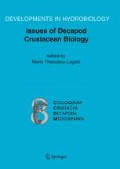Abstract
Some aspects of the reproductive biology of two hermit crabs Pagurus alatus (Fabricius, 1775) and P. excavatus (Herbst, 1791) were studied. Specimens were collected monthly from April 2000 to March 2001 on the continental shelf and the upper-middle slope off the Southwestern coasts of Sardinia, in the central-western Mediterranean Sea. Crab size (minimum and maximum shield length) was 1.7 and 9.5 mm for 1150 females of P. alatus; 4.0 and 10.4 mm for 347 females of P. excavatus, respectively. Females of P. alatus with ripe ovaries were only found in February-April and ovigerous females were observed throughout the year except in March, with the highest incidence in summer. Females of P. excavatus with fully developed ovaries were collected during all months of the year reaching a peak from April to June. Ovigerous females of P. excavatus occurred throughout the year and the main spawning period occurred in March and April. Fecundity of both species was calculated to assess seasonal variation of reproductive intensity and was positively correlated with the size of the individuals. Monthly fecundity did not reveal significant differences in P. alatus ovigerous females, whereas P. excavatus exhibited significant differences in monthly fecundity depending on the time of year. Difference in fecundity among P. alatus and P. excavatus can be related to the size of the ovigerous females and species of hermit crab, but their different reproductive strategies suggest that they are specifically related to different environmental conditions.
Access this chapter
Tax calculation will be finalised at checkout
Purchases are for personal use only
Preview
Unable to display preview. Download preview PDF.
References
Adensamer, T., 1898. Decapoden gesammelt auf S.M. Shiff “Pola” in den Jahren 1890–1894. Zoologische Ergebnisse XI. Denkschriften der Kaiserlichen Akademie der Wissenchaften. Mathematisch-Naturwissenschaften Klasse, Wien 65: 597–628.
Bastock, M., 1967. Courtship: an Ethological Study. Aldine, Chicago.
Bouvier, E. L., 1940. Dé capodes Marcheurs. Faune de France 37: 1–404.
Campisi, S., M. Mura & A. Cau, 1998. Biological aspects of Plesionika antigai (Zariquiey Álvarez, 1955) (Crustacea: Decapoda: Pandalidae) in central-western Mediterranean. Journal of Natural History 32: 1453–1462.
Carpine, C., 1970. Ecologie de l’étage bathyal dans la Méditerranée occidentale. Mémoires de l’Institut Océanographique, Monaco 2: 1–146.
Chintiroglou, C., D. Doumenc & D. Koutsoubas, 1992. Allométrie d’une nouvelle association entre le décapode anomoure Pagurus excavatus (Herbst, 1791) et léactinie acontiaire Sagartiogeton undatus (Müller, 1788). Crustaceana 62: 1–11.
Doumenc, D., C. Chintiroglou & A. Koukouras, 1985. Actinies de la Mer Egée: méthodes d’identification, zoogéographie. Bulletin du Muséum National d’Histoire Naturelle, Paris 7: 497–529.
Elwood, R. W., N. Marks & J. T. A. Dick, 1995. Consequences of shell-species preferences for female reproductive success in the hermit crab Pagurus bernhardus. Marine Biology 123: 431–434.
Hazlett, A. B., 1968. The sexual behavior of some european hermit crabs. Pubblicazioni della Stazione Zoologica di Napoli 36: 238–252.
Ingle, R. W., 1985. Northeastern Atlantic and Mediterranean hermit crabs (Crustacea: Anomura: Paguroidea: Paguridae). I. The genus Pagurus Fabricius, 1775. Journal of Natural History 19: 745–769.
Ingle, R. W., 1993. Hermit Crabs of the Northeastern Atlantic Ocean and Mediterranean Sea An Illustrated Key. Natural History Museum Publications and Chapman and Hall, London.
Lancaster, I., 1990. Reproduction and life history strategy of the hermit crab Pagurus bernhardus. Journal of the Marine Biological Association of the United Kingdom 70: 192–142.
Mainardi, D. & A. C. Rossi, 1969. Adamsia palliata and Calliactis parasitica on the same Pagurus excavatus (first record), and the problem of A. palliata as obligatory partner of P. prideauxi. Atti della Societa` Italiana di Scienze Naturali 109: 220–222.
Mantelatto, F. L. M. & R. B. Garcia, 1999. Reproductive potential of the hermit crab Calcinus tibicen (Crustacea, Anomura) from Ubatuba, Saö Paulo, Brazil. Journal of Crustacean Biology 19: 268–275.
Mazzi, V., 1977. Manuale di Tecniche Istologiche e Istochimiche. Piccin Editore, Padova.
Mura, M. & A. Cau, 2002. Biologia riperoduttiva di Pagurus excavatus (Fabricius, 1775) (Crustacea; Paguridae) nel Canale di Sardegna. Biologia Marina Mediterranea 9: 770–773.
Mura, M., F. Orrù & A. Cau, 2001. Biologia riproduttiva di Pagurus alatus (Fabricius, 1775) (Crustacea; Paguridae) nel Canale di Sardegna. Biologia Marina Mediterranea 8: 741–744.
Pax, F. & J. Müller, 1962. Die Anthozoenfauna der Adria. Fauna Flora Adriatica 3: 1–343.
Pérès, J. M. & J. Picard, 1964. Nouveau manuel de bionomie benthique de la mer Méditerrané. Recueil des Travaux de la Station Marine d’Endoume 31: 1–137.
Ross, D. M., 1979. “Stealing” of the symbiotic anemone, Calliactis parasitica, in intraspecific and interspecific encounters of three species of Mediterranean pagurids. Canadian Journal of Zoology 6: 1181–1189.
ŠtevŠić, Z., 1990. Check-list of the Adriatic Decapod Crustacea. Acta Adriatica 31: 183–274.
Urzelai, A., T. Elizalde, T. Capellan, I. Esteban, A. Quiroga, I. Zabala & M. Ibañez, 1990. Estudio preliminar de las comunidades de Pagurus alatus Fabricius, 1775 y Parapagurus pilosimanus S.I. Smith, 1879 (Crustacea Decapoda) y Epizoanthus paguriphilus Verril, 1883 (Anthozoa Zoantarida) de la fosa de Cap Breton (Golfo de Vizcaya). Lurralde 13: 193–206.
Wilber, T. P. Jr., 1989. Associations between gastropod shell characteristics and egg production in hermit crab Pagurus longicarpus. Oecologia 81: 6–15.
Zariquiey Álvarez, R., 1968. Crustáceos Decápodos Ibéricos. Investigación Pesquera 32: 1–510.
Author information
Authors and Affiliations
Editor information
Editors and Affiliations
Rights and permissions
Copyright information
© 2006 Springer
About this chapter
Cite this chapter
Mura, M., Orrù, F., Cau, A. (2006). Reproduction strategy of the deep-sea hermit crabs Pagurus alatus and Pagurus excavatus of the Central-Western Mediterranean Sea. In: Thessalou-Legaki, M. (eds) Issues of Decapod Crustacean Biology. Developments in Hydrobiology, vol 184. Springer, Dordrecht. https://doi.org/10.1007/1-4020-4756-8_7
Download citation
DOI: https://doi.org/10.1007/1-4020-4756-8_7
Publisher Name: Springer, Dordrecht
Print ISBN: 978-1-4020-4599-8
Online ISBN: 978-1-4020-4756-5
eBook Packages: Biomedical and Life SciencesBiomedical and Life Sciences (R0)

